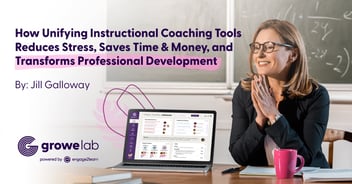Choosing the Right Instructional Coaching Model and Platform
Instructional coaching has emerged as a powerful tool in the field of education, providing students and educators with personalized support and guidance to unlock their full potential. However, with the abundance of instructional coaching models available, choosing the right one can be a daunting task.
What is a Coaching Model in Education?
A coaching model in education is a framework through which an educator navigates the instructional coaching cycle. The purpose of coaching models in education is to close the student achievement gap and accelerate learning by assisting teachers in implementing improved instructional practices in their classrooms.
RELATED: Why Even the Best Teachers Need Coaches
Key Considerations When Selecting a Coaching Model or System
- Understand the Goals and Objectives
The first step in choosing the right coaching model is to clearly define your goals and objectives. Determine which specific competencies the coach and coachee will be working on to attain proficiency and how those will be evidenced. Understanding your desired outcomes will help you align the coaching model to your specific needs.
- Recognize the Human-Centered Approach
An effective coaching model should be learner centered, placing the learner's needs, strengths, and weaknesses at the core. Consider models that empower educators to set their own learning objectives, reflect on their progress, and take ownership of their growth. A human-centered approach nurtures autonomy and fosters a culture of continuous improvement.
- Research Evidence-Based Models
Look for coaching models backed by research and real implementation results. Models supported by research are more likely to yield positive results and effectively support professional development for educators.
- Consider the Context and Setting
Every educational institution is unique, and the coaching model should be tailored to fit your specific context and setting. Factors such as a school or district's size, the age group of students, and the existing learning culture should all be considered.
- Emphasize Continuous Growth
A coaching model that promotes consistent and continuous improvement is crucial for sustainable success. Continuous improvement is best achieved when coaching occurs on a regular, scheduled, and predictable basis. Look for models that encourage ongoing assessment, feedback, and adjustments, as flexibility is key in the dynamic field of education.
- Involve Stakeholders
Engage all relevant stakeholders, including teachers and district and school administrators, in the decision-making process. Seeking their input and support will enhance the acceptance of the chosen coaching model and increase its chances of success.
- Measure Success
Identify measurable indicators to evaluate the success of the coaching model. These indicators could include student outcomes, teacher satisfaction, student engagement, and overall institutional improvement. Regularly assess progress and make data-informed decisions to continually optimize the coaching process.
- Connect Growth to Outcomes
Connecting coaching and educator growth data to outcomes data – such as student assessment data, state test scores, or teacher advancement – allows school and district leaders to understand what’s working and what’s not.
RELATED: How to Transform Your Professional Learning with Evidence-Based Coaching
Two Widely Used Instructional Coaching Models
01: The Impact Cycle Model by Jim Knight, Instructional Coaching Group
Foundation: Jim Knight’s research as a PhD and an associate at the University of Kansas Center for Research of Learning
Audience: New and experienced teachers
Focus:
- Partnership between coach and teacher coachee
- The teacher as the final decision-maker on goals, practices to adopt, and interpreting data
- Video observation of practice
- Reflective coaching conversations
Process:
- Identify
The teacher gains a clear picture of their present reality by watching a video of their instruction. The teacher identifies a student-focused goal and teaching strategy with support from the coach.
- Learn
The coach shares different teaching strategies and models while the teacher observes. Then, the coach prompts the teacher to practice.
- Improve
The teacher implements the practice in the classroom. Data is collected on student progress and the teacher’s implementation of the process. The coach and teacher meet to confirm direction and monitor progress. Adjustments are made and next actions are planned.
Coaching Delivery Method: Video, supported by The Impact Cycle: What Instructional Coaches Should Do to Foster Powerful Improvements in Teaching by Jim Knight, teacher strategy checklists, and virtual or face-to-face coaching meetings.
02: The See it, Name it, Do It Coaching Model by Paul Bambrick-Santoyo
Foundation: Paul Bambrick-Santoyo’s experiences, including:
- Leading North Star Academies in Newark, NJ, with results ranking among the highest-achieving urban schools in the country
- Chief Schools Officer for Uncommon Schools
- Founder of Leverage Leadership Institute
Audience: New and experienced teachers
Focus:
- Observation of teacher, modeled example by coach, practice, reflection, and repetition
- Teachers' focus on one action step at a time and defining improvement using a rubric or criteria
- Coach feedback that is actionable, specific, and includes ongoing support
Process:
- See It
Part 1: Coaches create opportunities for the teacher to see their success from a previously observed lesson by providing precise praise.
Part 2: During classroom observation, the coach identifies a high-leverage skill for improvement. Coaches use pre-developed charts or guides to help them identify practices for improvement.
During the follow-up coaching meeting, the coach shows the teacher an exemplar video model (from an online library), or alternatively, models the desired behavior personally. The teacher is then encouraged to compare this demonstration with their own practice for the skill in question.
- Name It
Once improvement areas are identified, the coach helps the teacher find the correct action step. The action step must be observable, high leverage, and manageable. The coach asks questions to narrow the focus on a specific action step and ensure that the teacher understands the rationale for that action step.
- Do It
Teachers engage in active practice of the action step alongside the coach during the coaching meeting. This involves role playing and/or incorporating scripted changes into the teacher’s lessons. The coach would provide the teacher with feedback and further modeling as needed. Subsequently, during the next classroom observation, the coach will intentionally look for the implementation of the chosen action step.
Coaching Delivery Method: An online video library, supported by action steps and sequences in Get Better Faster by Paul Bambrick-Santoyo.
GroweLab, the All-In-One Instructional Coaching Platform from engage2learn
Regardless of which coaching model your school or district adopts, it can be supported and facilitated by GroweLab, the all-in-one, coaching-model-agnostic platform for educators.
-
GroweLab empowers coaches to efficiently manage, document, and monitor all their coaching activities online. As instructional coaches observe, evaluate, and track the progress of educators, utilizing a single, user-friendly tool for continuous documentation and real-time feedback allows for open communication between educator and coach, optimizes time for all parties involved, and equips educators with distinct, actionable next steps.
-
GroweLab offers 24/7 access to a vast and growing digital library of vetted resources, tools, templates, online courses, and video workshops that are aligned to competencies, state and national standards, as well as targeted areas of focus.
-
GroweLab connects educator growth and student achievement data to show the ROI and impact of coaching through a user-friendly data dashboard. Centralizing all data points in a single location enhances integration, analysis, and visualization, empowering leaders and coaches to identify patterns, monitor progress, and make data-informed decisions more effectively.
Choosing the right coaching model is a critical step in ensuring the success of education coaching initiatives. Regardless of the coaching model employed by your school or district, GroweLab is ready to document, organize, and streamline all of your instructional coaching and educator support.
Ready to learn more about GroweLab and level up your coaching program? Get a demo today.


